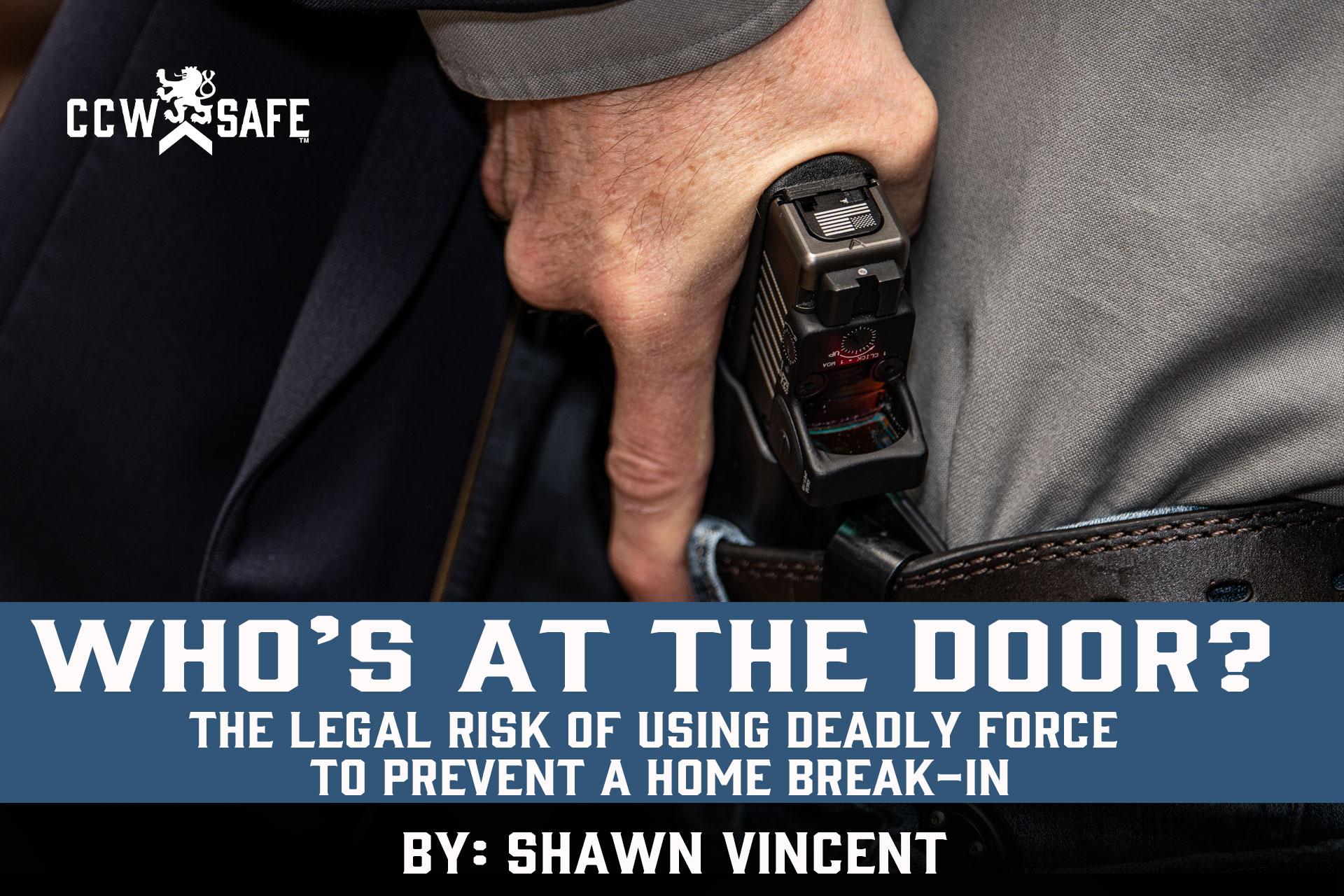
Posted on August 2, 2019
Who’s at the Door?
Who’s at the Door?
The Legal Risk of Using Deadly Force to Prevent a Home Break-in
Skyler David Ryce knew the two men, Ky Jones and Jeremy Burdine, who were trying to break into his home on a Saturday afternoon in Wichita, Kansas. According to a spokesperson for the Wichita Police Department, Ryce had a bad history with Jones and Burdine, and apparently the intruders had come to retrieve some disputed property. They failed.
Ryce, who owned the home, fired through his front front door, striking both intruders. When police arrived on the scene, officers found Jones and Burdine lying in the yard, bloodied by multiple gunshot wounds. They died later at the hospital.
Police arrested Ryce — but not for the shooting. They found stolen property at his home. A spokesperson noted that it was not the property Jones and Burdine had come for. Police seemed convinced that the men were trying to force their way into Ryce’s home, and the homeowner appears justified in his use of force.
In most of the cases we explore, the threshold for justifying lethal force is the reasonable fear of imminent death or great bodily harm. In Ryce’s case, however, one could argue that the threat posed by Jones and Burdine wasn’t necessarily imminent; they were on the other side of a locked door.
Don West, veteran criminal defense attorney and National Trial Counsel for CCW Safe, notes that many states have statutes that allow the use of deadly for the purposes of preventing an aggravated felony. Robbery, murder, rape, kidnapping: each is an aggrevated felony — and so is home invasion. In many states, if someone is breaking into your house, the element of reasonable fear is presumed. “It’s your house,” West says, “and if someone is trying to force their way in, your use of force is presumed reasonable.”
However, in such a circumstance — when death or bodily harm is not imminent — West warns, “you have to be right, and you have to be able to perceive the circumstances correctly.”
We’ve written extensively about the Ted Wafer case where Wafer, the homeowner, was awoken very late at night by violent banging on his front door. He presumed that someone was trying to break in. He opened the front door to confront the intruder, and shot the shadowy figure he met standing on his porch. The trouble was, the so-called intruder was actually an unarmed 19-year-old girl who was drunk, high, disoriented, injured, and probably looking for help. Wafer misjudged the situation, and he was convicted of second degree murder.
It seems clear that Ryce knew that the men at his front door were Jones and Burdine, and he likely knew their intentions and what they were capable of doing if they managed to break in. There was little chance, we can assume, that Ryce was misjudging the situation. But, still, there was a chance. That means Ryce took a legal risk when he decided to fire through his locked front door. He was betting his freedom that the circumstance was as he perceived it.
We’ve written about another case where a CCW Safe member — the owner of a house on a 10-acre ranch — was surprised to find a man on his porch shortly before midnight. Shirtless and shoeless, the man was bleeding from his head and angrily demanding to be let inside. The homeowner’s wife took the children to a secluded room and called 911. During the 20 minutes it took for sheriff’s deputies to arrive at the remote ranch, the property owner waited patiently with his gun drawn, warning the intruder through a window that if he entered the home, he’d be shot. At one point, the intruder used the front porch swing as a battering ram on the front door, but the homeowner kept his cool, resolved not to fire unless the man actually forced his way inside. He recognized the high legal risk he would take by firing through a window or a closed door. He knew he’d be more justified in using deadly force once the man broke in.
In the end, deputies arrived and apprehended the intruder. No shots were fired.
In most states, a homeowner is permitted to use deadly force to stop someone from breaking into their home. The lesson for the concealed carrier and gun owners concerned about home defense is that, if you choose to use deadly force to prevent a break-in before there is an imminent threat of death or great bodily injury, you are taking a legal gamble that you are correct about all the details surrounding the circumstances. If you are mistaken, the shooting could be deemed unjustified. Good judgement requires weighing the immediate risk to yourself and your family against the legal risk of acting too soon or being wrong about the nature of the threat.
 |
SHAWN VINCENT- LITIGATION CONSULTANTShawn Vincent is a litigation consultant who helps select juries in self-defense cases, and he manages public interest of high-profile legal matters. If you have any questions for Shawn, or would like more articles like this, let us know belo |